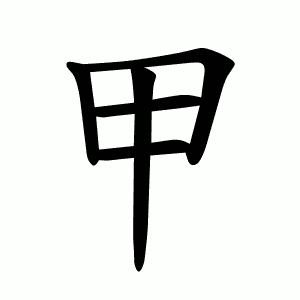甲
- armor;
- shell;
- carapace;
- scale;
The first of the Ten Heavenly Stems (十天干); by extension, “first,” “foremost,” or “best.”
Also used for the outer protective covering of animals (e.g., shells of turtles and crustaceans), and figuratively for anything that serves as protection or ranking in the foremost position.
Etymology
Originally a pictographic character depicting either a shell or protective casing.
Seal and bronze forms suggest the image of a cracked surface or patterned shield, resembling the ridged plates of tortoise shell or armor.
According to Shuowen Jiezi (說文解字):
「甲,介也。从田象甲胄之形。」
“甲 means armor; formed from the shape of a breastplate.”
The earliest forms in oracle-bone inscriptions (甲骨文) sometimes resemble 十 (ten) or 田 (field), representing a divided or sectioned surface.
This duality in ancient script led to varied interpretations — some see 甲 as:
- armor plates protecting the body,
- turtle shell used for divination,
- cracked shell lines employed in oracle writing (hence 甲骨文, “inscriptions on bone and shell”).
As time passed, the term extended to denote outer shells, protective layers, and ordered sequence, including its position as the first of the Ten Heavenly Stems.
Usage in Korean
甲 (갑) — armor; first; best
甲冑 (갑주) — armor and helmet; panoply
甲胄士 (갑주사) — armored soldier
甲乙丙丁 (갑을병정) — the Ten Heavenly Stems sequence
甲子年 (갑자년) — the year of 甲子 in the sexagenary cycle
甲骨文 (갑골문) — oracle-bone script (literally “shell-bone script”)
甲殼 (갑각) — shell; carapace
甲板 (갑판) — deck of a ship (lit. “armor plank”)
甲類 (갑류) — first class; highest rank
甲等 (갑등) — first grade; superior class
美甲師 (미갑사) — nail artist (lit. “beauty-armor master”)
甲申 (갑신) — one of the sixty cyclical combinations
甲辰 (갑진) — one of the sixty cyclical combinations
Words that derived from 甲
Additional notes
As the first of the Ten Heavenly Stems (十天干), 甲 symbolizes beginning, leadership, and the east.
In the Five Elements (五行), it corresponds to Wood (木) — specifically to the yang aspect of wood (陽木), representing growth, vitality, and spring.
Its associated direction is east (東) and color green or blue (靑).
Thus, in the cosmological sense:
Element: 木 (yang wood)
Direction: 東
Season: 春
Color: 青 / 綠
The Kangxi Dictionary (康熙字典) gives:
「甲,介也,象甲冑之形。又十干之首。」
“甲 means armor; shaped like a cuirass; also the first of the ten heavenly stems.”
As armor (甲冑), it symbolizes protection and readiness; as ordinal (天干之首), it represents the beginning of cycles and excellence in order.
Hence, 甲 became synonymous with “first, foremost, superior” — a meaning preserved in modern usage such as 甲級 (first-class) and 甲等 (highest grade).
During the Japanese colonial period, the same term was used in grading systems, where 甲 denoted the top score or highest rank, followed by 乙 (second) and 丙 (third).
In modern Chinese, 甲 also acquired extended meanings:
Nail (손톱, 발톱) — as the hard protective covering of fingers/toes.
Shell or carapace — as in 甲殼類 (crustaceans).
Methyl group (化學) — in organic chemistry nomenclature.
“Best / top-rated” — e.g., 甲級選手 (“A-class player”).
Oracle forms show 十 or 田-like grids (interpreted as the surface of a shell).
Bronze forms emphasize a square divided by lines — symbolic of both armor plates and turtle shells.
In modern script, the rectangular symmetry of 甲 makes it a common emblematic motif (e.g., in seals and rankings).
Across cultures and eras, 甲 stands as a mark of origin, excellence, and defense — the first among ranks, the shell that guards, and the starting point of cycles.
Alternative forms
𠇚
𡴌
